Thermal Effects on Photovoltaic Array Performance: Experimentation, Modeling, and Simulation
Abstract
Featured Application
Abstract
1. Introduction
2. Experimental Setup
3. Thermal Model
4. CFD Model
5. Results
5.1. Experimental Results
5.2. CFD Results
6. Conclusions
Author Contributions
Funding
Institutional Review Board Statement
Informed Consent Statement
Data Availability Statement
Conflicts of Interest
Abbreviations
| CFD | Computational fluid dynamics |
| PV | Photovoltaic |
References
- Iakovidis, F.; Ting, D.S.K. Effect of Free Stream Turbulence on Air Cooling of a Surrogate PV Panel. In Proceedings of the ASME 2014 International Mechanical Engineering Congress and Exposition, Montreal, QC, Canada, 14–20 November 2014. [Google Scholar] [CrossRef]
- Jubayer, C.M.; Hangan, H. Numerical simulation of wind effects on a stand-alone ground mounted photovoltaic (PV) system. J. Wind Eng. Ind. Aerodyn. 2014, 134, 56–64. [Google Scholar] [CrossRef]
- Abiola-Ogedengbe, A. Experimental Investigation of Wind Effect on Solar Panels. Master’s Thesis, University of Western Ontario, London, ON, Canada, 2013. [Google Scholar]
- Mahboub, C.; Moummi, N.; Moummi, A.; Youcef-Ali, S. Effect of the angle of attack on the wind convection coefficient. Sol. Energy 2011, 85, 776–780. [Google Scholar] [CrossRef]
- Palyvos, J. A survey of wind convection coefficient correlations for building envelope energy systems’ modeling. Appl. Therm. Eng. 2008, 28, 801–808. [Google Scholar] [CrossRef]
- Sartori, E. Convection coefficient equations for forced air flow over flat surfaces. Sol. Energy 2006, 80, 1063–1071. [Google Scholar] [CrossRef]
- Loveday, D.; Taki, A. Convective heat transfer coefficients at a plane surface on a full-scale building facade. Int. J. Heat Mass Transf. 1996, 39, 1729–1742. [Google Scholar] [CrossRef]
- Test, F.; Lessmann, R.; Johary, A. Heat transfer during wind flow over rectangular bodies in the natural environment. J. Heat Transf. 1981, 103, 262–267. [Google Scholar] [CrossRef]
- McAdams, W.H.A. Heat Transmission; McGraw-Hill: New York, NY, USA, 1954. [Google Scholar]
- Sharples, S.; Charlesworth, P. Full-scale measurements of wind-induced convective heat transfer from a roof-mounted flat plate solar collector. Sol. Energy 1998, 62, 69–77. [Google Scholar] [CrossRef]
- Sparrow, E.M.; Ramsey, J.; Mass, E. Effect of finite width on heat transfer and fluid flow about an inclined rectangular plate. J. Heat Transf. 1979, 101, 199–204. [Google Scholar] [CrossRef]
- Onur, N. Forced convection heat transfer from a flat-plate model collector on roof of a model house. Wärme-Und StoffüBertrag. 1993, 28, 141–145. [Google Scholar] [CrossRef]
- Vasel, A.; Iakovidis, F. The effect of wind direction on the performance of solar PV plants. Energy Convers. Manag. 2017, 153, 455–461. [Google Scholar] [CrossRef]
- Wu, Y.Y.; Wu, S.Y.; Xiao, L. Numerical study on convection heat transfer from inclined PV panel under windy environment. Sol. Energy 2017, 149, 1–12. [Google Scholar] [CrossRef]
- Wu, S.Y.; Wu, Y.Y.; Xiao, L.; Yang, Z. Experimental study of natural convection heat transfer from a nonuniformly heated flat plate simulating PV panel. J. Mech. Sci. Technol. 2018, 32, 423–432. [Google Scholar] [CrossRef]
- Ghabuzyan, L.; Kuo, J.; Baldus-Jeursen, C. Quantifying the Effects of Convective Heat Transfer on Photovoltaic Performance and Optimal Tilt Angle. In ASME International Mechanical Engineering Congress and Exposition; American Society of Mechanical Engineers: Portland, OR, USA, 2020. [Google Scholar]
- Ogundimu, E.; Akinlabi, E.; Mgbemene, C. Maximizing The Output Power Harvest of a Pv Panel: A Critical Review. J. Phys. Conf. Ser. IOP Publ. 2019, 1378, 032054. [Google Scholar] [CrossRef]
- Bhattacharya, T.; Chakraborty, A.K.; Pal, K. Effects of ambient temperature and wind speed on performance of monocrystalline solar photovoltaic module in Tripura, India. J. Sol. Energy 2014, 2014, 817078. [Google Scholar] [CrossRef]
- Ma, T.; Zhao, J.; Li, Z. Mathematical modelling and sensitivity analysis of solar photovoltaic panel integrated with phase change material. Appl. Energy 2018, 228, 1147–1158. [Google Scholar] [CrossRef]
- Goverde, H.; Goossens, D.; Govaerts, J.; Catthoor, F.; Baert, K.; Poortmans, J.; Driesen, J. Spatial and temporal analysis of wind effects on PV modules: Consequences for electrical power evaluation. Sol. Energy 2017, 147, 292–299. [Google Scholar] [CrossRef]
- Prilliman, M.; Stein, J.S.; Riley, D.; Tamizhmani, G. Transient Weighted Moving-Average Model of Photovoltaic Module Back-Surface Temperature. In Proceedings of the 2020 47th IEEE Photovoltaic Specialists Conference (PVSC), Calgary, OR, Canada, 15 June–21 August 2020. [Google Scholar]
- Coskun, C.; Toygar, U.; Sarpdag, O.; Oktay, Z. Sensitivity analysis of implicit correlations for photovoltaic module temperature: A review. J. Clean. Prod. 2017, 164, 1474–1485. [Google Scholar] [CrossRef]
- PVsyst 7 Help: Array Thermal Losses. 2019. Available online: https://www.pvsyst.com/help/index.html?thermal_loss.htm (accessed on 23 December 2020).
- Oliphant, M. Measurement of wind speed distributions across a solar collector. Sol. Energy 1980, 24, 403–405. [Google Scholar] [CrossRef]
- Olsen, T.; Preus, R. Small Wind Site Assessment Guidelines; Technical Report; National Renewable Energy Lab. (NREL): Golden, CO, USA, 2015.
- Fields, J.; Oteri, F.; Preus, R.; Baring-Gould, I. Deployment of Wind Turbines in the Built Environment: Risks, Lessons, and Recommended Practices; Technical Report; National Renewable Energy Lab. (NREL): Golden, CO, USA, 2016. [CrossRef]
- McMahon, T. Accelerated testing and failure of thin-film PV modules. Prog. Photovolt. Res. Appl. 2004, 12, 235–248. [Google Scholar] [CrossRef]
- Lee, Y.; Tay, A.A. Finite element thermal stress analysis of a solar photovoltaic module. In Proceedings of the 2011 37th IEEE Photovoltaic Specialists Conference, Seattle, WA, USA, 19–24 June 2011; pp. 3179–3184. [Google Scholar] [CrossRef]

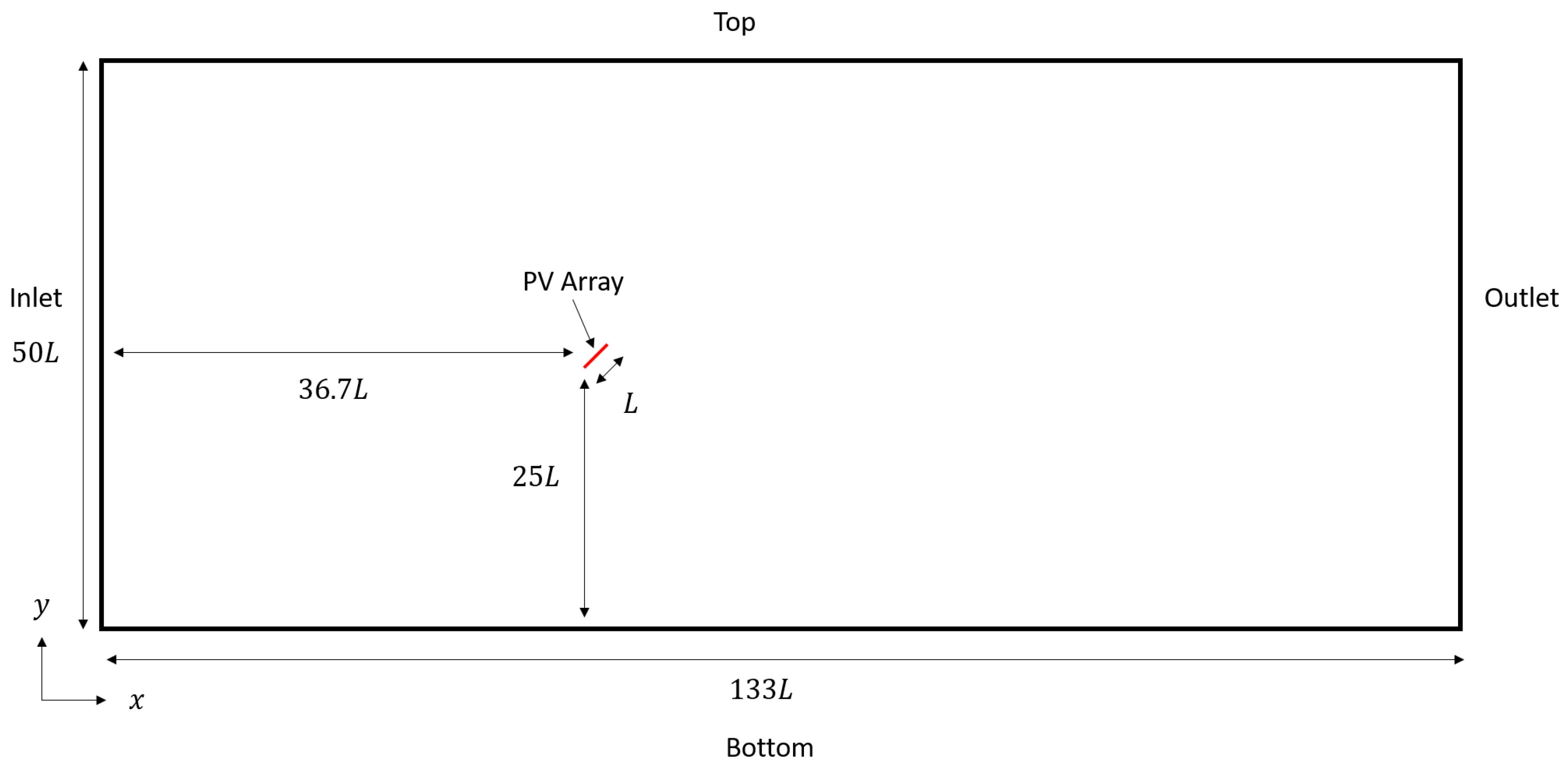
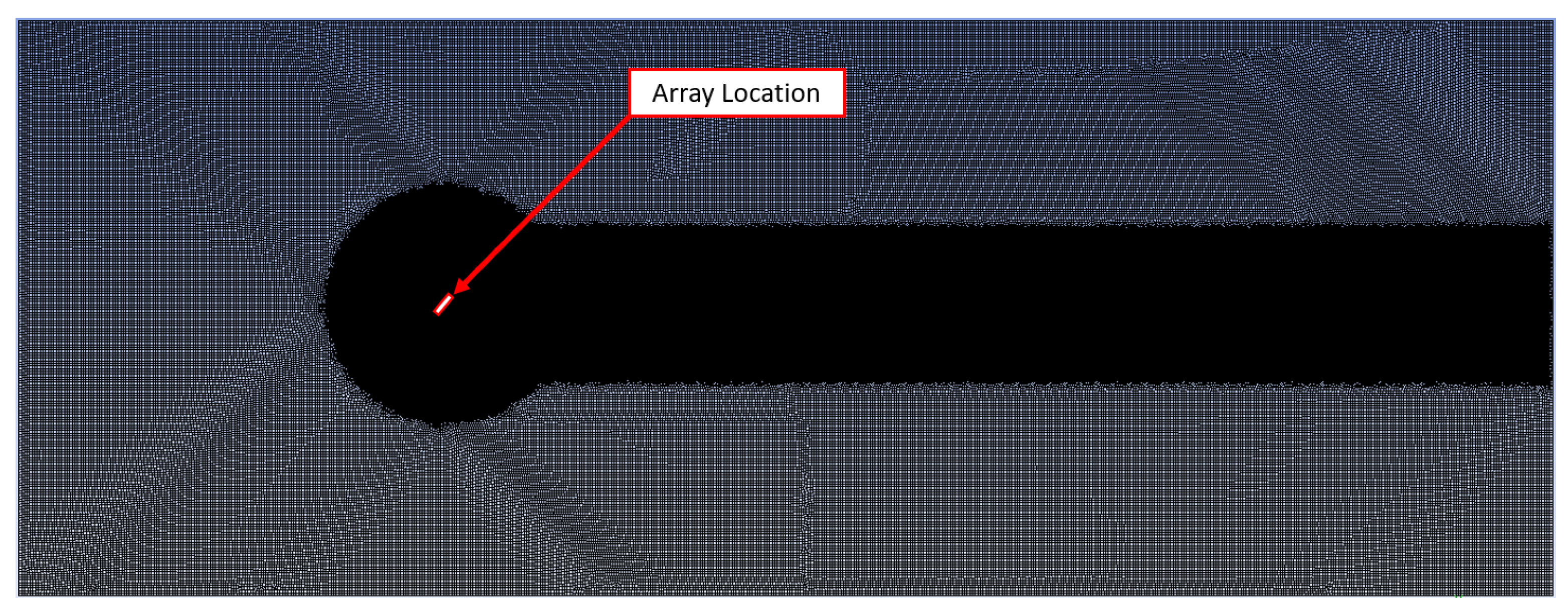
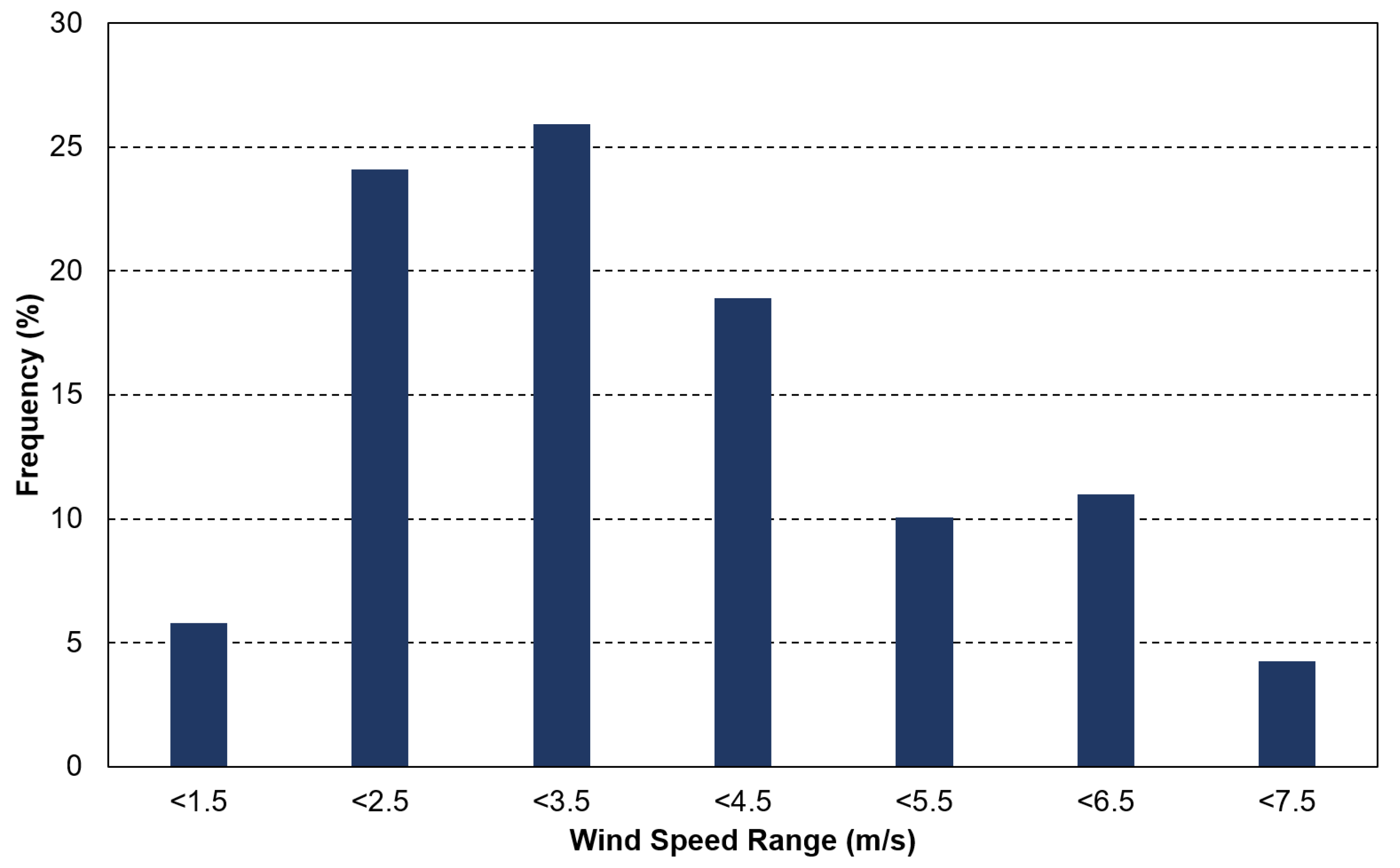
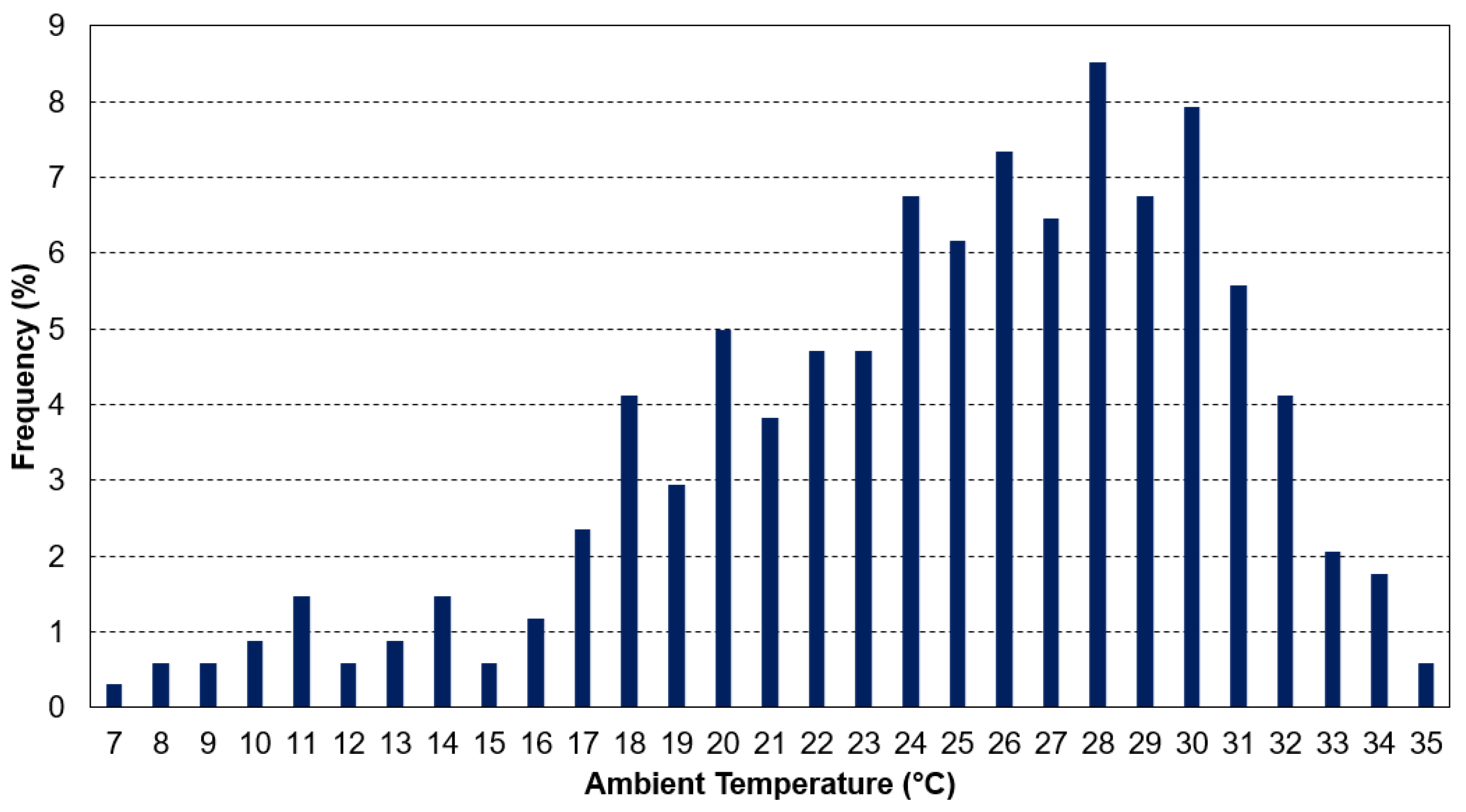
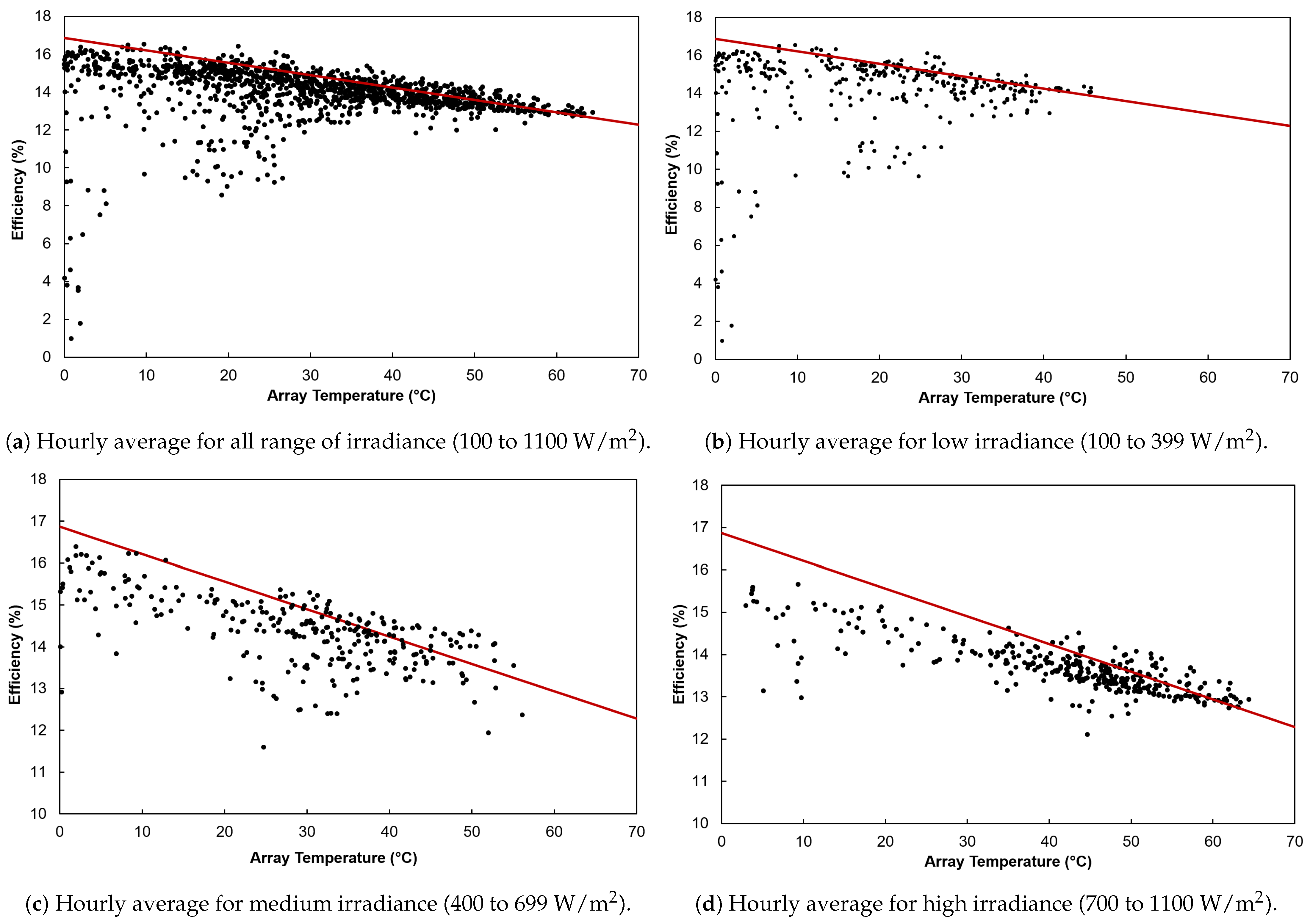
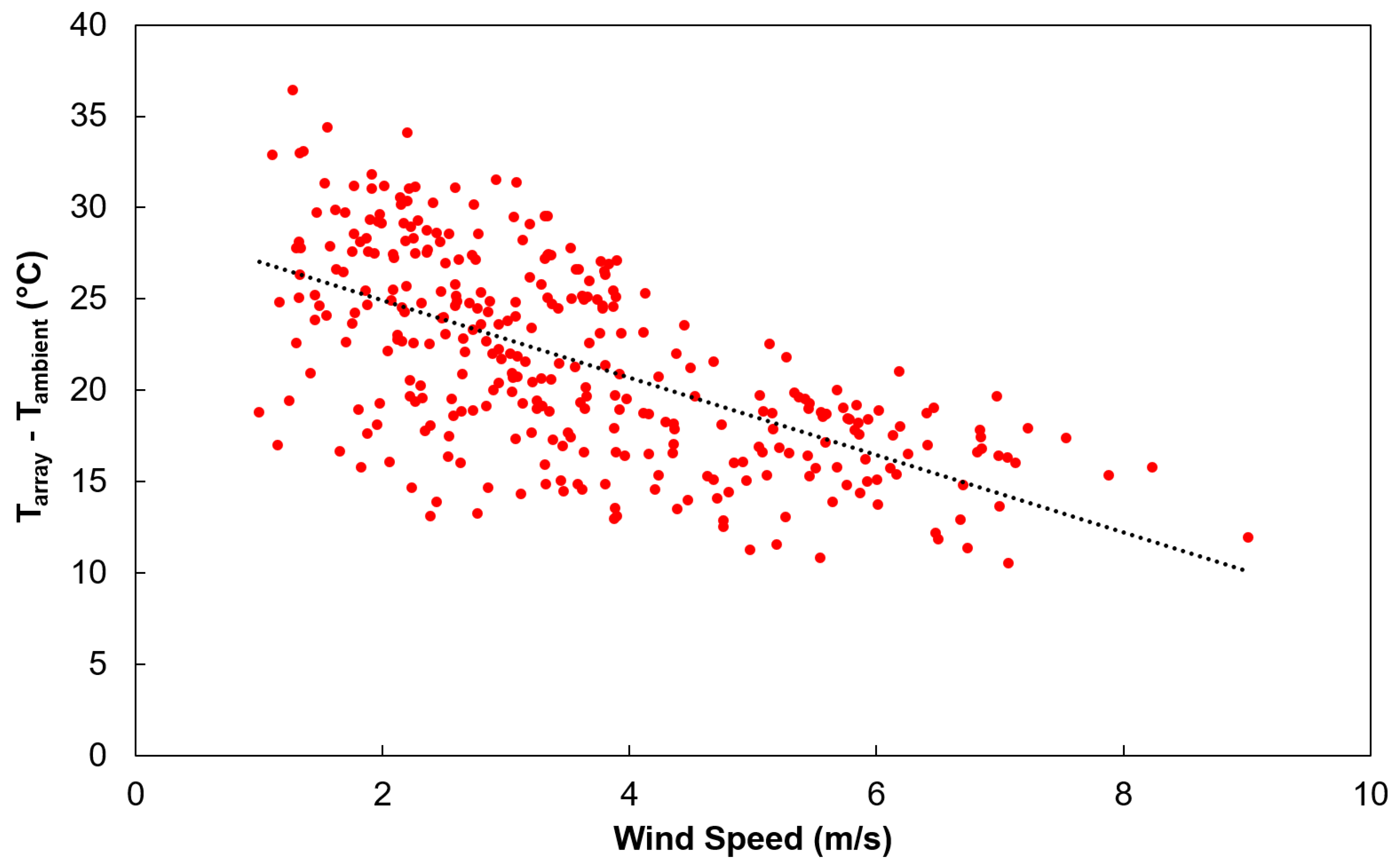
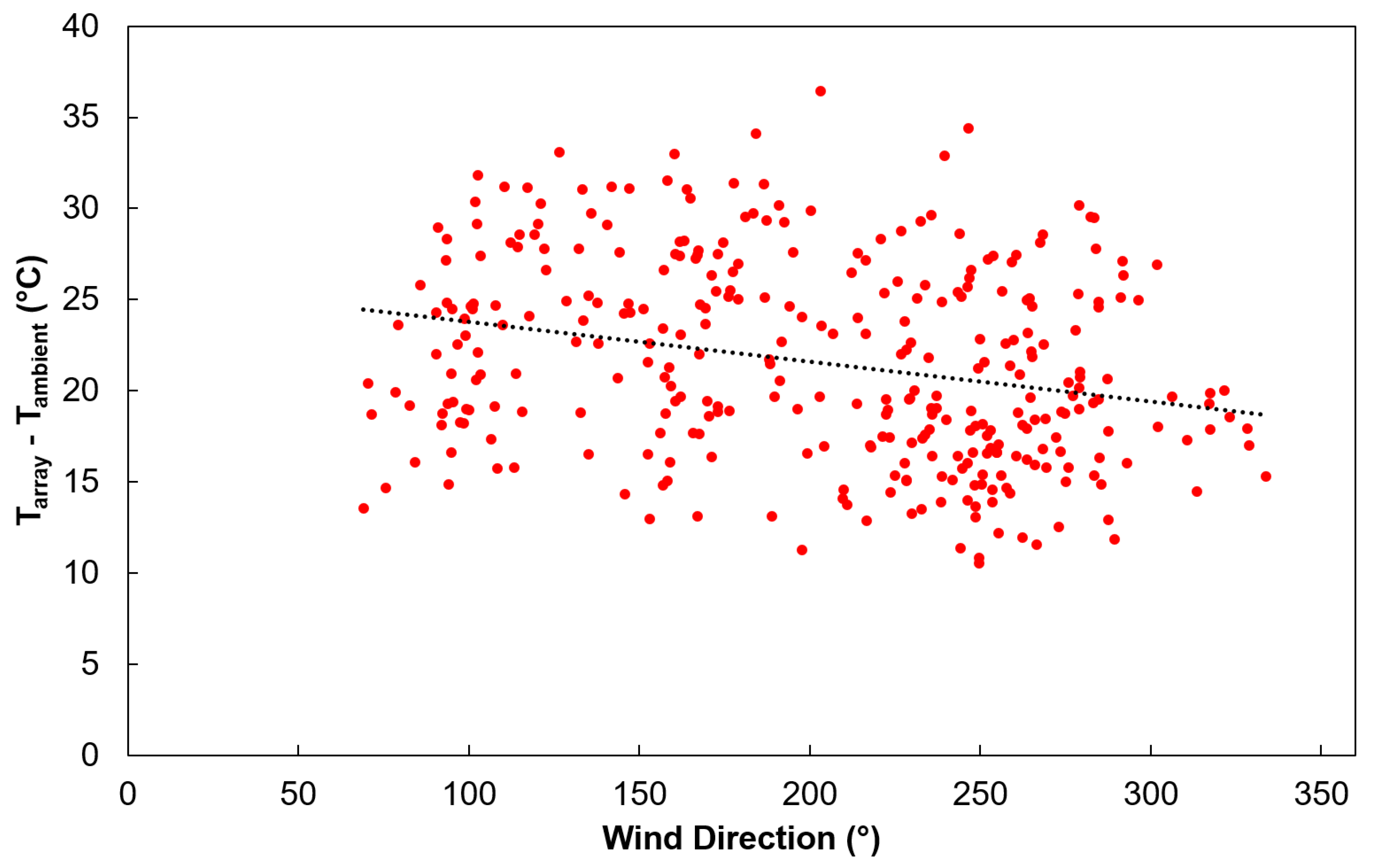
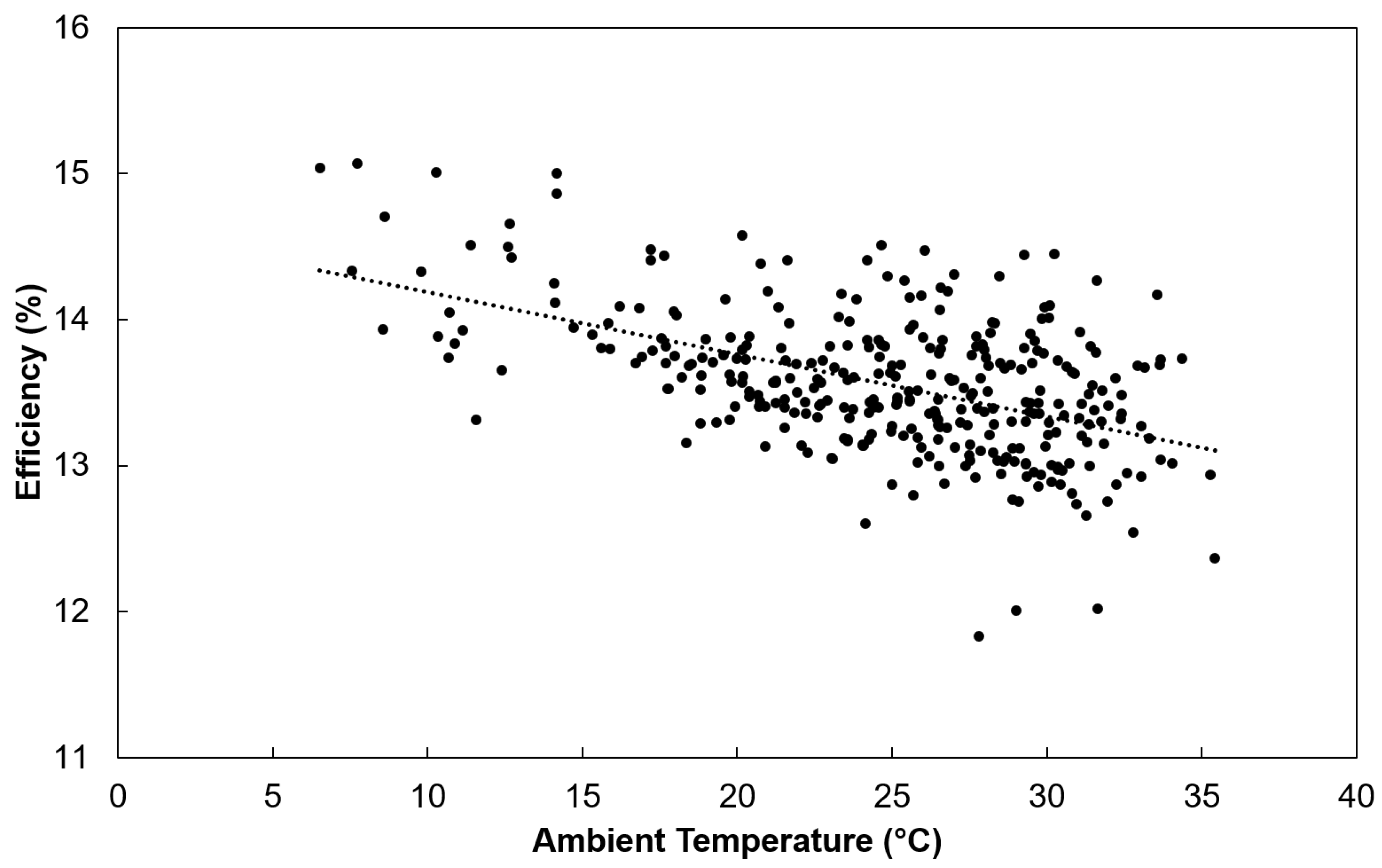

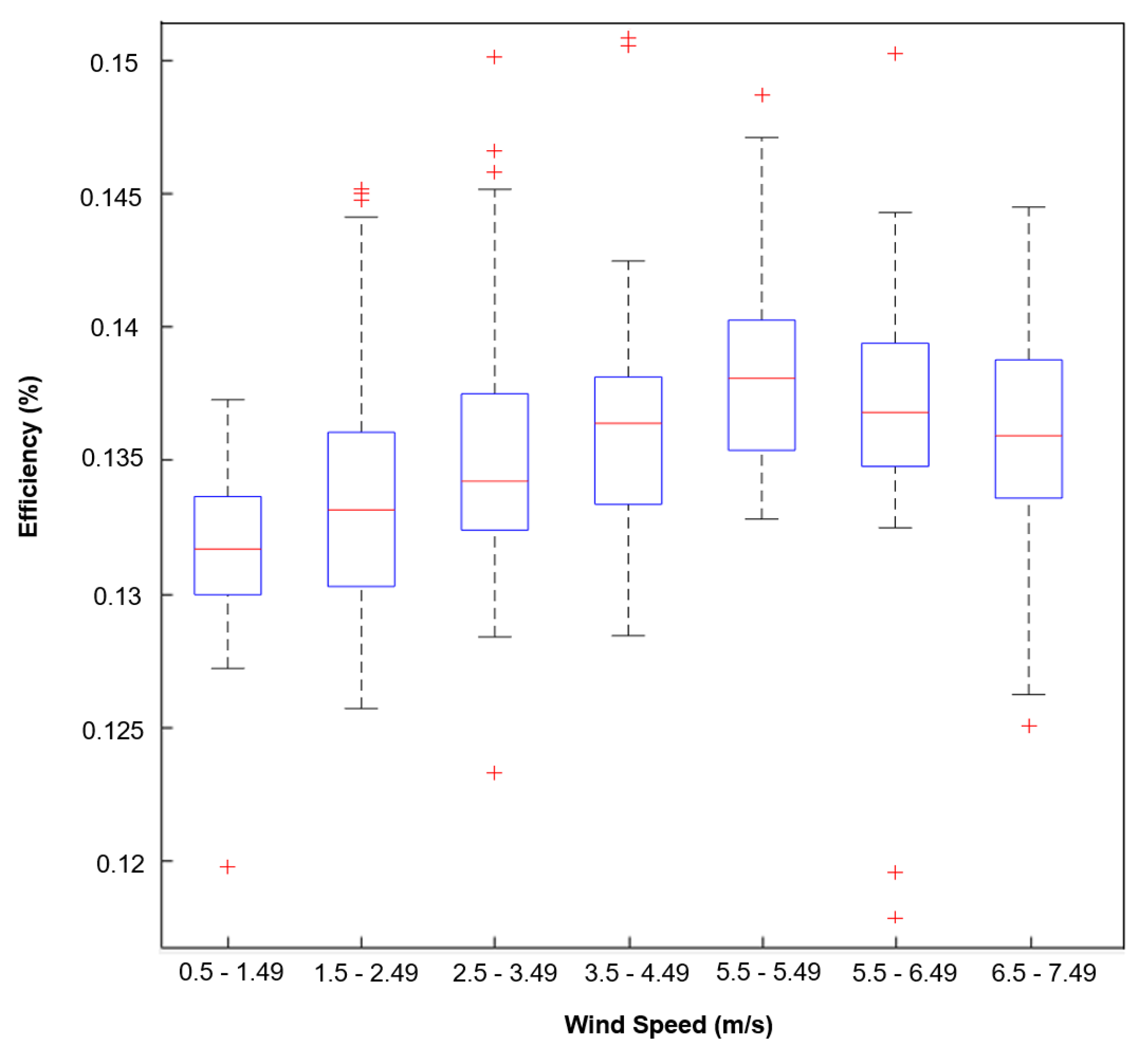
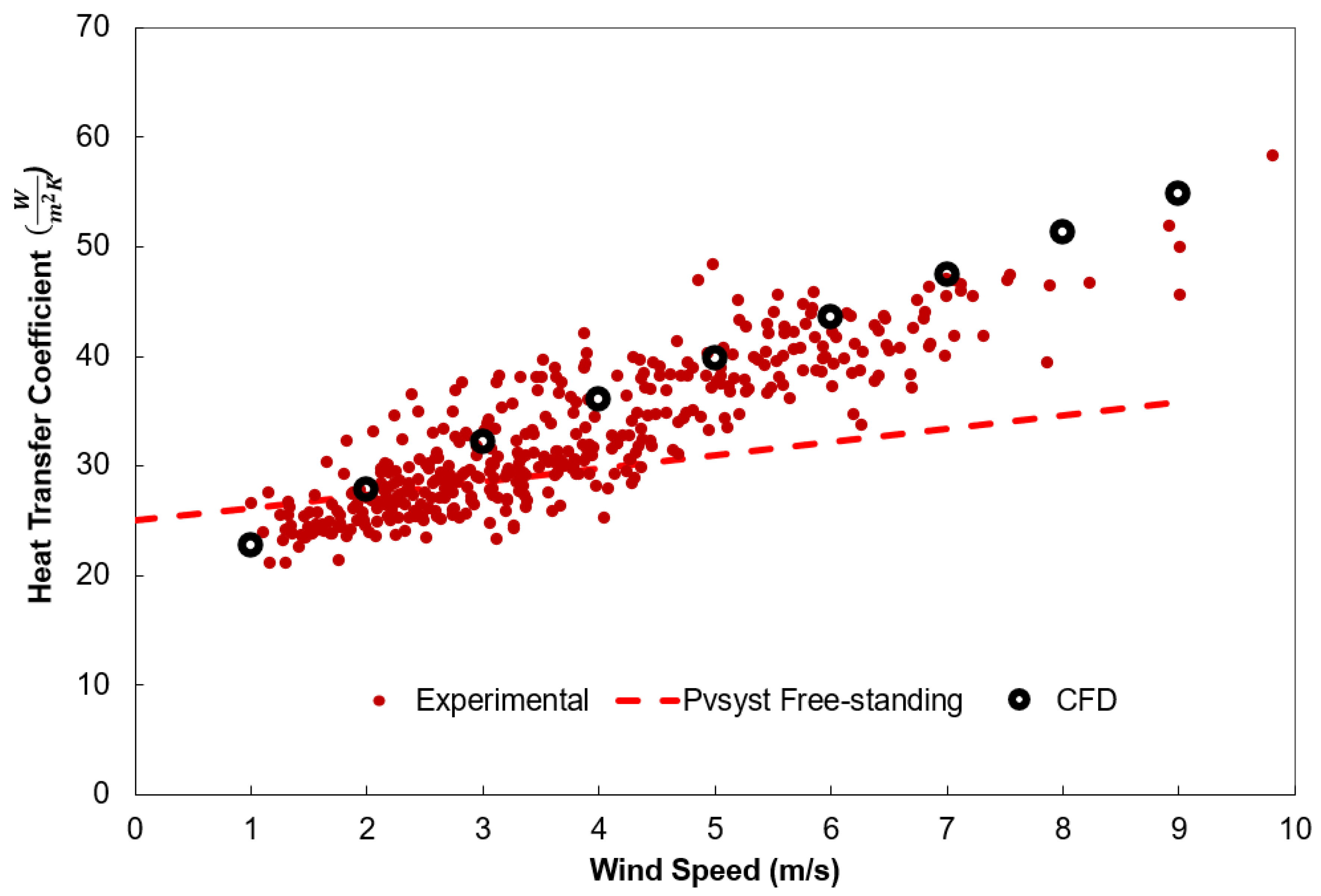
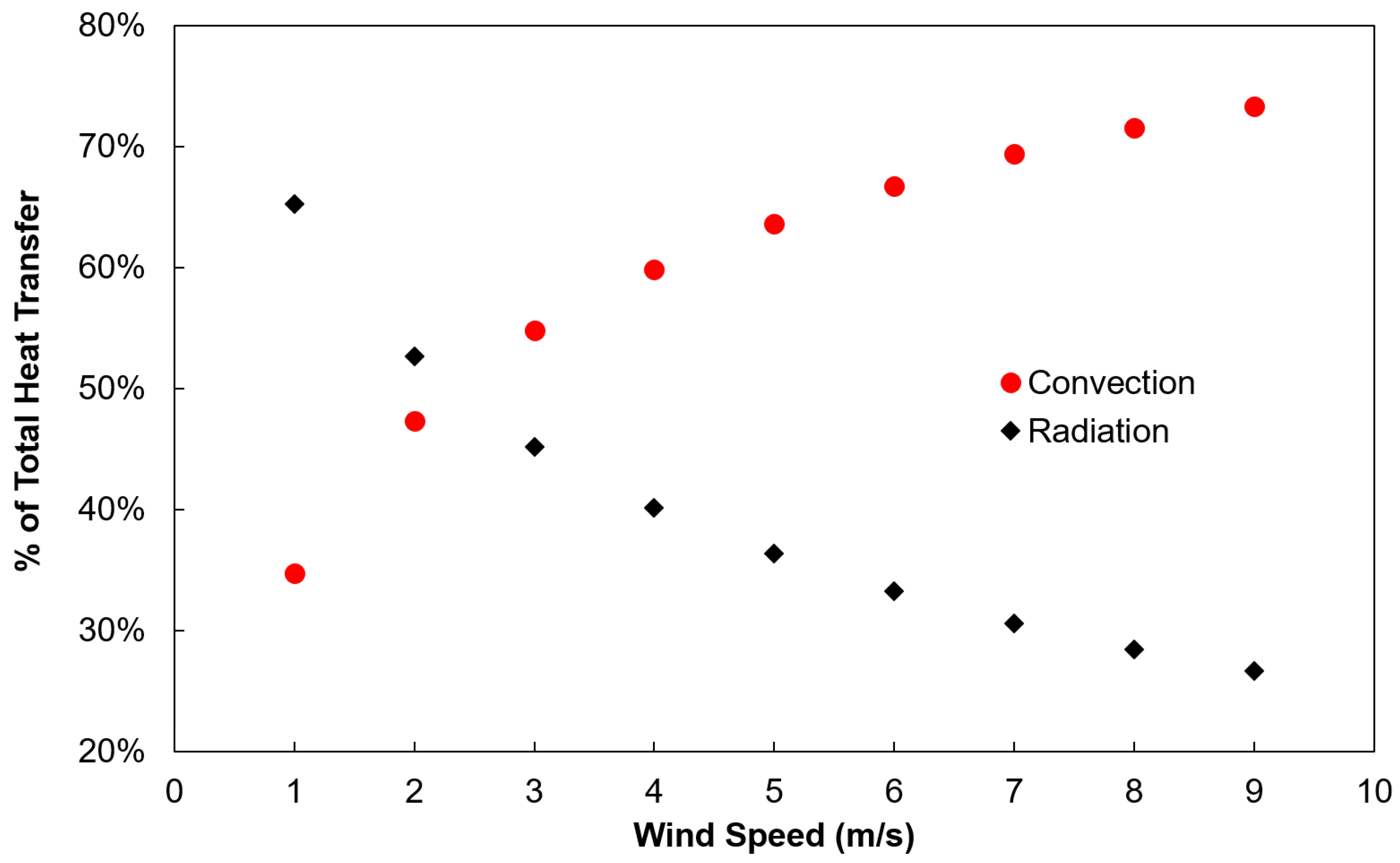
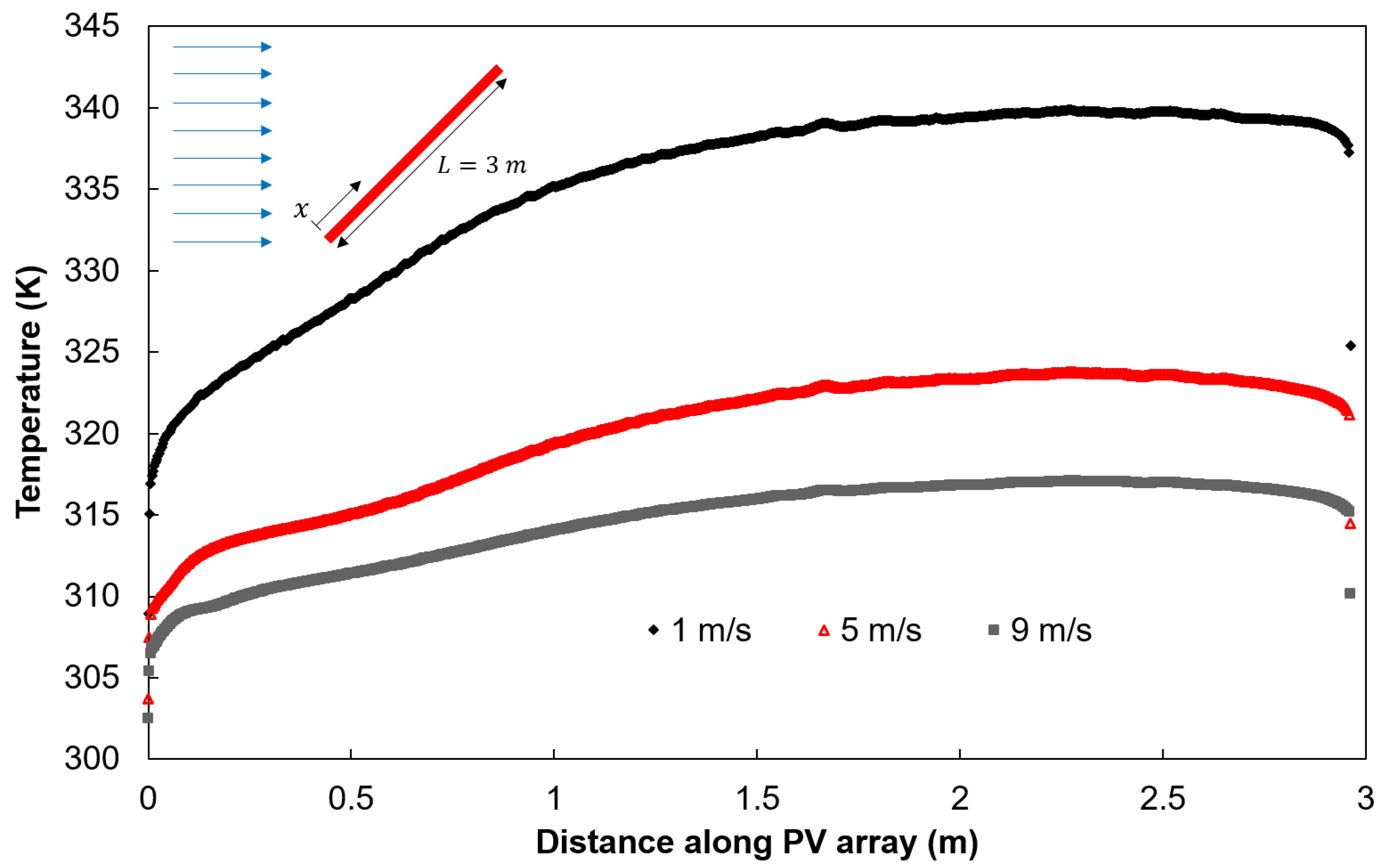
| Correlation | Reference |
|---|---|
| Sartori [6] | |
| Loveday and Taki [7] | |
| Test et al. [8] | |
| Goswami et al. [9] | |
| Sharples et al. [10] | |
| Sparrow [11] | |
| Onur [12] |
| Parameter Name | Symbol | Value |
|---|---|---|
| Reference Efficiency | 15.23% | |
| Reference Temperature | 25 °C | |
| Absorptivity | 0.9 | |
| Temperature Coefficient | −0.43%/°C |
| Equipment | Accuracy | Sample Rate |
|---|---|---|
| RM Young 2D Ultrasonic Anemometer | ±2% | 0.1 Hz |
| Dycor DT85 with CEM20 Datataker | ±0.5% | 0.1 Hz |
| Accuenergy Acuvim II Smartmeter | ±0.2% | 0.1 Hz |
| Kipp & Zonen CMP10 Pyronometer | ±1.5% | 0.1 Hz |
| Kipp & Zonen CMP22 Pyronometer | ±1.5% | 0.1 Hz |
| Omega SA1XL Thermocouple | ±0.7 °C | 0.1 Hz |
| Mesh | Number of Cells | Heat Transfer Coefficient (W/m2·K) |
|---|---|---|
| Mesh 1 | 176,409 | 49.12 |
| Mesh 2 | 319,311 | 47.53 |
| Mesh 3 | 383,599 | 47.47 |
| Mesh 4 | 627,830 | 47.48 |
| Free-Standing | Fully Insulated Backside | Large System | Free-Standing | Current | |
|---|---|---|---|---|---|
| (NWD) | (NWD) | (NWD) | (WD) | (WD) | |
| (W/m2·K) | 29 | 15 | 29 | 25 | 15–25 |
| (W/m2·K/(m/s)) | 0 | 0 | 0 | 1.2 | 3.5 |
Publisher’s Note: MDPI stays neutral with regard to jurisdictional claims in published maps and institutional affiliations. |
© 2021 by the authors. Licensee MDPI, Basel, Switzerland. This article is an open access article distributed under the terms and conditions of the Creative Commons Attribution (CC BY) license (http://creativecommons.org/licenses/by/4.0/).
Share and Cite
Ghabuzyan, L.; Pan, K.; Fatahi, A.; Kuo, J.; Baldus-Jeursen, C. Thermal Effects on Photovoltaic Array Performance: Experimentation, Modeling, and Simulation. Appl. Sci. 2021, 11, 1460. https://doi.org/10.3390/app11041460
Ghabuzyan L, Pan K, Fatahi A, Kuo J, Baldus-Jeursen C. Thermal Effects on Photovoltaic Array Performance: Experimentation, Modeling, and Simulation. Applied Sciences. 2021; 11(4):1460. https://doi.org/10.3390/app11041460
Chicago/Turabian StyleGhabuzyan, Levon, Kevin Pan, Arianna Fatahi, Jim Kuo, and Christopher Baldus-Jeursen. 2021. "Thermal Effects on Photovoltaic Array Performance: Experimentation, Modeling, and Simulation" Applied Sciences 11, no. 4: 1460. https://doi.org/10.3390/app11041460
APA StyleGhabuzyan, L., Pan, K., Fatahi, A., Kuo, J., & Baldus-Jeursen, C. (2021). Thermal Effects on Photovoltaic Array Performance: Experimentation, Modeling, and Simulation. Applied Sciences, 11(4), 1460. https://doi.org/10.3390/app11041460





